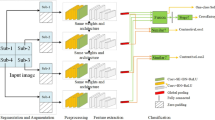Abstract
In this paper, we present an experiment to evaluate the performance of deep-learning-based steganalysis methods under different steganographic algorithms and payloads. We designed and implemented a simple and efficient convolutional neural network (CNN) steganalysis model. This model combines SRM [10] filters and 2D Gabor filters to initialize the CNN’s filters in the feature extraction layers. The extracted features are passed to a fully connected neural network classifier to detect images containing hidden messages. We generated several datasets using different steganographic algorithms and payloads to train and test our CNN model. We designed several experiments to evaluate the detection rate of the proposed model under separate training-testing conditions.
Access this chapter
Tax calculation will be finalised at checkout
Purchases are for personal use only
Similar content being viewed by others
References
Liu, J., et al.: Recent advances of image steganography with generative adversarial networks. IEEE Access 8, 60575–60597 (2020). https://doi.org/10.1109/ACCESS.2020.2983175
Pevny, T., Filler, T., Bas, P.: Using high-dimensional image models to perform highly undetectable steganography. In: International Workshop on Information Hiding, pp. 161–177 (2010). https://doi.org/10.1007/978-3-642-16435-4_13
Sedighi, V., Cogranne, R., Fridrich, J.: Content-Adaptive Steganography by minimizing statistical detectability. IEEE Trans. Inf. Forensics Secur. 11(2), 221–234 (2016). https://doi.org/10.1109/TIFS.2015.2486744
Holub, V., Fridrich, J., Denemark, T.: Universal distortion function for steganography in an arbitrary domain. EURASIP J. Inf. Sec. 1(1)(2014). https://doi.org/10.1186/1687-417X-2014-1
Holub, V., Fridrich, J.: Designing steganographic distortion using directional filters. In: 2012 IEEE International Workshop on Information Forensics and Security (WIFS), pp. 234–239 (2012).https://doi.org/10.1109/WIFS.2012.6412655
Chandramouli, Rajarathnam, Kharrazi, Mehdi, Memon, Nasir: Image steganography and steganalysis: concepts and practice. In: Kalker, Ton, Cox, Ingemar, Ro, Yong Man (eds.) IWDW 2003. LNCS, vol. 2939, pp. 35–49. Springer, Heidelberg (2004). https://doi.org/10.1007/978-3-540-24624-4_3
English, R.: Comparison of high capacity steganography techniques. In: 2010 International Conference of Soft Computing and Pattern Recognition, pp. 448–453 (2010). https://doi.org/10.1109/SOCPAR.2010.5686507
Ye, J., Ni, J., Yi, Y.: Deep learning hierarchical representations for image steganalysis. IEEE Trans. Inf. Forensics Secur. 12(11), 2545–2557 (2017). https://doi.org/10.1109/TIFS.2017.2710946
Fridrich, J., Kodovsky, J.: Rich Models for Steganalysis of Digital Images. IEEE Trans. Inf. Forensics Secur. 7(3), 868–882 (2012). https://doi.org/10.1109/TIFS.2012.2190402
Vojtech, O., Fridrich, J.: Digital image steganography using universal distortion. In: ACM Workshop on Information Hiding and Multimedia Security, Association for Computing Machinery (2013)
Kodovsky, J., Fridrich, J., Holub, V.: Ensemble classifiers for steganalysis of digital media. IEEE Trans. Inf. Forensics Secur. 7(2), 432–444 (2012). https://doi.org/10.1109/TIFS.2011.2175919
Tan, S., Li, B.: Stacked convolutional auto-encoders for steganalysis of digital images. In: Signal and Information Processing Association Annual Summit and Conference (APSIPA), 2014, Asia-Pacific, pp. 1–4 (2014). https://doi.org/10.1109/APSIPA.2014.7041565
Qian, Y., Dong, J., Wang, W., Tan, T.: Deep learning for Steganalysis via convolutional neural networks. In: Media Watermarking, Security, and Forensics 2015, vol. 9409, pp. 171–180, March 2015. https://doi.org/10.1117/12.2083479
Pibre, L., Pasquet, J., Ienco, D., Chaumont, M.: Deep learning is a good Steganalysis Tool when embedding key is reused for different images, even if there is a cover source mismatch. Electr. Imag. Media Watermark. Secur. Forensics 2016(8), 1–11 (2016). https://doi.org/10.2352/ISSN.2470-1173.2016.8.MWSF-078
Xu, G., Wu, H.-Z., Shi, Y.-Q.: Structural design of convolutional neural networks for Steganalysis. IEEE Signal Process. Lett. 23(5), 708–712 (2016). https://doi.org/10.1109/LSP.2016.2548421
Yu, J., Li, F., Cheng, H., Zhang, X.: Spatial Steganalysis Using Contrast of Residuals. IEEE Signal Process. Lett. 23(7), 989–992 (2016). https://doi.org/10.1109/LSP.2016.2575100
Sedighi, V., Fridrich, J.: Histogram layer, moving convolutional neural networks towards feature-based Steganalysis. Electr. Imag. Media Watermark. Secur. Forensics 2017(6), 50–55 (2017). https://doi.org/10.2352/ISSN.2470-1173.2017.7.MWSF-325
Yedroudj, M., Comby, F., Chaumont, M.: Yedroudj-Net: an efficient CNN for spatial Steganalysis. In: 2018 IEEE International Conference on Acoustics, Speech and Signal Processing (ICASSP), pp. 2092–2096 (2018). https://doi.org/10.1109/ICASSP.2018.8461438
El Beji, R., Saidi, M., Hermassi, H., Rhouma, R.: An improved CNN Steganalysis architecture based on catalyst kernels and transfer learning. International Conference on Digital Economy 325, 119–128 (2018). https://doi.org/10.1007/978-3-319-97749-2_9
Boroumand, M., Chen, M., Fridrich, J.: Deep residual network for Steganalysis of digital images. IEEE Trans. Inf. Forensics Secur. 14(5), 1181–1193 (2019). https://doi.org/10.1109/TIFS.2018.2871749
Zhang, R., Zhu, F., Liu, J., Liu, G.: Depth-wise separable convolutions and multi-level pooling for an efficient spatial CNN-based Steganalysis. IEEE Trans. Inf. Forensics Secur. 15, 1138–1150 (2020). https://doi.org/10.1109/TIFS.2019.2936913
Arivazhagan, S., Amrutha, E., Sylvia Lilly Jebarani, W., Veena, S.T.: Hybrid convolutional neural network architecture driven by residual features for steganalysis of spatial steganographic algorithms. Neural Comput. Appl. 33, 11465–11485 (2021). https://doi.org/10.1007/s00521-021-05837-7
Reinel, T.-S., et al.: GBRAS-Net: a convolutional neural network architecture for spatial image Steganalysis. IEEE Access 9, 14340–14350 (2021). https://doi.org/10.1109/ACCESS.2021.3052494
Chen, M., Sedighi, V., Boroumand, M., Fridrich, J.: JPEG-phase-aware convolutional neural network for steganalysis of JPEG images. In: Proceedings of the 5th ACM Workshop on Information Hiding and Multimedia Security, pp. 75–84 (2017). https://doi.org/10.1145/3082031.3083248
Song, X., Liu, F., Yang, F.G., Luo, X., Zhang, Y.: Steganalysis of adaptive JPEG steganography using 2D Gabor filters. In: Proceedings of the 3rd ACM Workshop on Information Hiding and Multimedia Security, pp. 15–23 (2015). https://doi.org/10.1145/2756601.2756608
Bas, P., Filler, T., Pevny, T.: Break our steganographic system: the ins and outs of organizing BOSS. International Workshop on Information Hiding 6958, 59–70 (2011). https://doi.org/10.1007/978-3-642-24178-9_5
Holub, V., Sedighi, V., Denemark, T., Fridrich, J.: Steganographic Algorithms. DDE Lab at Binghamton University, NY (2012). http://dde.binghamton.edu/download/stego_algorithms/. Accessed 13 Apr 2022
Author information
Authors and Affiliations
Corresponding author
Editor information
Editors and Affiliations
Rights and permissions
Copyright information
© 2022 The Author(s), under exclusive license to Springer Nature Switzerland AG
About this paper
Cite this paper
Dwaik, A., Belkhouche, Y. (2022). Analysis of Deep Learning-Based Image Steganalysis Methods Under Different Steganographic Algorithms. In: Bebis, G., et al. Advances in Visual Computing. ISVC 2022. Lecture Notes in Computer Science, vol 13599. Springer, Cham. https://doi.org/10.1007/978-3-031-20716-7_22
Download citation
DOI: https://doi.org/10.1007/978-3-031-20716-7_22
Published:
Publisher Name: Springer, Cham
Print ISBN: 978-3-031-20715-0
Online ISBN: 978-3-031-20716-7
eBook Packages: Computer ScienceComputer Science (R0)




